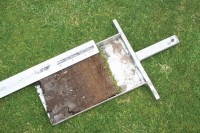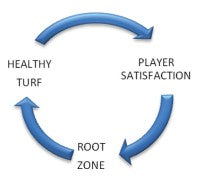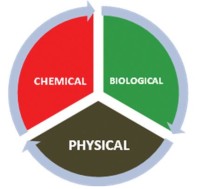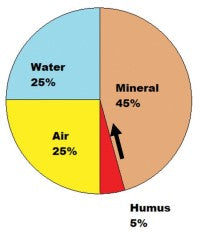Getting to the root of the problem!
 "It was no more than a marketing tool designed to confuse the reader into purchasing more product than was necessary for his turf surfaces"
"It was no more than a marketing tool designed to confuse the reader into purchasing more product than was necessary for his turf surfaces"
On visiting a recent customer, I came across a soil survey report carried out by a company with the intention to help the turf manager identify soil based conditions. The 'report' would have looked great on a university library shelf, but of little value in helping the manager understand what was going on under his turf. It was stuffed full of graphs, colour drawings and data tables, and unintelligible for practical use. Reading between the lines, it became apparent that it was no more than a marketing tool designed to confuse the reader into purchasing more product than was necessary for his turf surfaces.
So, how do you distinguish between a good, reliable soil report and one that totally baffles the recipient?
Don't get me wrong. A rootzone survey should be a sophisticated management tool, but it must give a comprehensive and an understandable picture of a wide set of parameters that affect plant production.
The objective of a rootzone survey is to understand the underlying parameters that are affecting root development and adversely affecting turf performance and maintenance costs. A report should have the following headings:
1. Cation exchange capacities
2. Major nutrient status
3. Important trace elements
4. pH and base saturation
5. Organic matter levels
6. Micro-biological activity levels
The objective should also be to identify imbalances in the rootzone which are:
- impacting adversely on the quality of the playing surface
- affecting the health and durability of the turf
- adding unnecessarily to maintenance costs
- and then to advise on remedies.
Let me explain a little further by looking, in more detail, at the required parameters for optimum turf health.
Rootzone Fertility
Healthy Turf
 Player satisfaction, our pay masters, depends on a healthy turf that gives good playing surfaces. Healthy sports turf depends on a vigorous root system and to be effective, a good root system needs the right environment in which to develop. The condition of the rootzone has an important impact on nutrient uptake and the resultant quality and durability of the turf.
Player satisfaction, our pay masters, depends on a healthy turf that gives good playing surfaces. Healthy sports turf depends on a vigorous root system and to be effective, a good root system needs the right environment in which to develop. The condition of the rootzone has an important impact on nutrient uptake and the resultant quality and durability of the turf.
A Team of 3
Soil is all about physics, chemistry and biology. These three components of the growing medium are interrelated and each affects the workings of the other. We have excellent sand-based rootzones that can give the correct physical performance when managed correctly.
Unfortunately, the chemical aspect is often overloaded by huge inputs of synthetic fertilisers and pesticides (right). In this case, the biological aspect is also put out of balance, the rootzone suffers from thatch build-up and black layer, and the playing surface suffers. The turf manager can only prepare high quality playing surfaces when the rootzone balance is right.
Ideal Rootzone
The three key components of the rootzone - physical, chemical and biological - must each make their contribution. A growing medium, to be naturally productive, must be "living" and, to encourage "life", the environment must be hospitable, i.e. 5% humus, 25% air, 25% water, 45% mineral.
Fertility is much more than NPK out of a bag. Encouraging natural fertility is about optimising the environment to ensure that the unseen workers - the beneficial microbes - can maximise their contribution to nutrient availability in the root zone resulting in balanced, healthy turf growth.
No Air = No Oxygen = No Life
Compaction combines a physical barrier with the exclusion of air, which has far reaching effects on "life" and the ability of the plant roots to work effectively. Introducing air into compacted playing surfaces is essential if the full benefit of remedial treatments  and the natural potential of the turf is to be realised.
and the natural potential of the turf is to be realised.
Humus
Referred to as Colloidal Organic Matter, humus has three times the exchange capacity of clay colloids. Humus is a key component of a productive growing medium and is particularly important for:
- physical structure
- improved tilth
- availability of plant nutrients
- increased water filtration
- decreased erosion
- less pollution
The key benefits of optimising the natural potential of the growing medium are healthier turf and less dependence on chemical inputs.
Clay Colloids
The clay colloids in soil are the exchange sites and consist of the smallest particles of clay, invisible to the naked eye, on which nutrients such as calcium, magnesium, sodium, potassium, trace elements and hydrogen are held.  These nutrients are known as cations, are positively charged and are held in varying proportions on the negatively charged clay colloids.
These nutrients are known as cations, are positively charged and are held in varying proportions on the negatively charged clay colloids.
Base Saturation
Base saturation measures the percentage make up of the cations on the clay colloid. As the exchange sites are always 100% occupied, the physical, chemical and biological attributes of the soil will often be reflected in the relationship of the cations on the base. For example, a soil with high magnesium will tend to be sticky and difficult to work.
Understanding pH
pH is often erroneously associated with the lime content of the soil, but it is actually a measure of the amount of hydrogen on the base. The more hydrogen the more acid in the soil; the less hydrogen the higher the pH. However, it does not follow that high pH soil is necessarily high in calcium. The exchange sites can be occupied by: magnesium, sodium and potassium, all of which displace the calcium on the base and keep up the pH. Therefore, despite a high pH, plants can be short of calcium. pH measurement alone is an insufficient guide to the calcium status of the growing medium, hence my company's Rootzone Survey looks at base saturation in detail.
Cation Exchange
Cation exchange is the process whereby plant roots absorb many of the essential nutrients. The process works through the secretion of exudates containing positively charged hydrogen ions, which swap in for the positively charged cations of calcium, magnesium, sodium, potassium and trace elements. 70% of cations absorbed by the plants go through the exchange process; hence, the imbalances on the base prevent balanced uptake, with adverse effects on the turf's ability to overcome stress, resist disease and produce high quality, durable playing surfaces.
Important parameters of rootzone revealed
Sand based and soil based growing mediums present very different management challenges. Measuring the physical characteristics of the rootzone in greater detail can provide a valuable insight into the contributory cause of problems and indicate the most appropriate remedial action.
Sand Particle Size
Sand based rootzones present a management challenge in themselves; more so if the actual sands used are widely divergent from the recommended standard. A wide range of particle sizes will compact, as in mixes designed for concrete. Sands for sports turf use are closely matched to produce a balance of water retention and gravitational drainage.
Benefits of a Root Survey
A good survey, carried out by a reputable company, provides the starting point for cost effective turf management which prioritises rootzone care by natural means, reducing the need for chemical dependence. For example, our approach enables managers to develop rootzone maintenance programmes more carefully matched to underlying construction - soil or sand - and to the pattern of use and to the needs of the varieties of bents, fescues and rye grass grown.
Which Area to Survey
 Even in areas of similar soil type, the performance of sportsturf can differ markedly from area to area. We recommend a minimum of three surveys so that a comparison is made between the best and worst areas, and an assessment can then be made of the underlying causes of disappointing performances with appropriate recommendations for remedial action.
Even in areas of similar soil type, the performance of sportsturf can differ markedly from area to area. We recommend a minimum of three surveys so that a comparison is made between the best and worst areas, and an assessment can then be made of the underlying causes of disappointing performances with appropriate recommendations for remedial action.
Follow Up
Your advisor should be able to work through the survey results with you, identifying how best to achieve the objectives of enhanced player satisfaction from the sportsturf in your care. Be very wary if your supplier ignores the results of a rootzone survey, or considers it 'not right for your situation'.
About the author: Andy Turnbull is Managing Director of The Great Turf Company, specialists in Activated Microbial Turf Management.
Email: andrewt@greatturfcompany.com www.greatturfcompany.com
